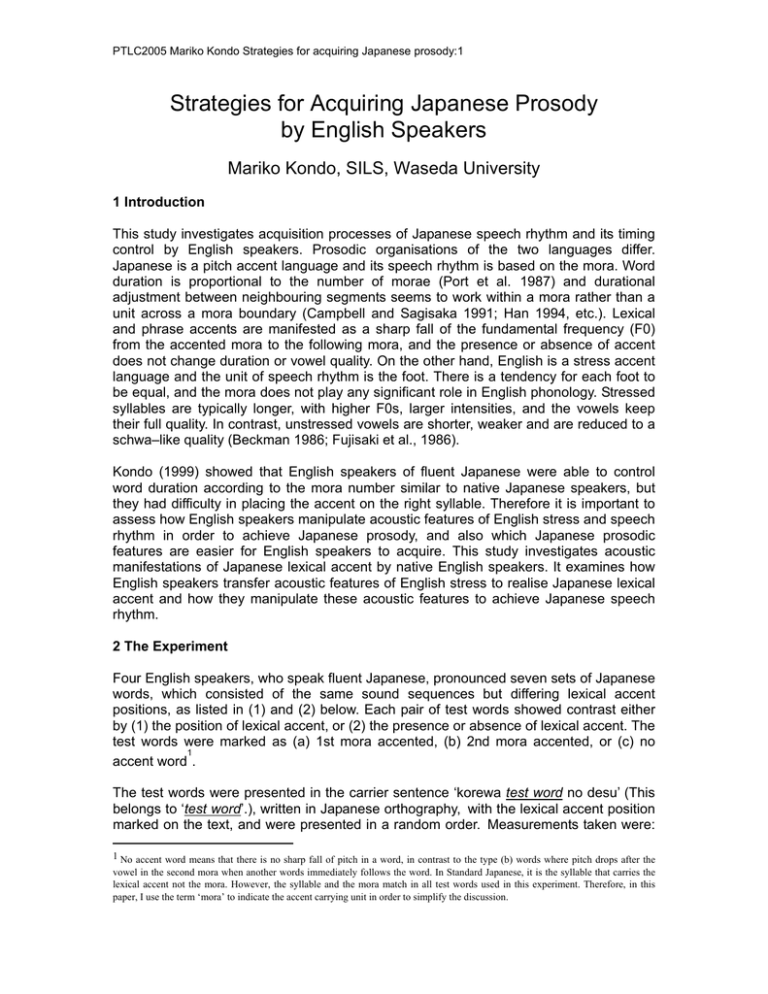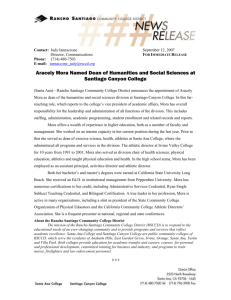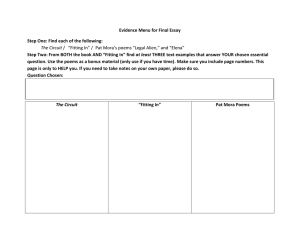Strategies for Acquiring Japanese Prosody by English Speakers
advertisement

PTLC2005 Mariko Kondo Strategies for acquiring Japanese prosody:1 Strategies for Acquiring Japanese Prosody by English Speakers Mariko Kondo, SILS, Waseda University 1 Introduction This study investigates acquisition processes of Japanese speech rhythm and its timing control by English speakers. Prosodic organisations of the two languages differ. Japanese is a pitch accent language and its speech rhythm is based on the mora. Word duration is proportional to the number of morae (Port et al. 1987) and durational adjustment between neighbouring segments seems to work within a mora rather than a unit across a mora boundary (Campbell and Sagisaka 1991; Han 1994, etc.). Lexical and phrase accents are manifested as a sharp fall of the fundamental frequency (F0) from the accented mora to the following mora, and the presence or absence of accent does not change duration or vowel quality. On the other hand, English is a stress accent language and the unit of speech rhythm is the foot. There is a tendency for each foot to be equal, and the mora does not play any significant role in English phonology. Stressed syllables are typically longer, with higher F0s, larger intensities, and the vowels keep their full quality. In contrast, unstressed vowels are shorter, weaker and are reduced to a schwa–like quality (Beckman 1986; Fujisaki et al., 1986). Kondo (1999) showed that English speakers of fluent Japanese were able to control word duration according to the mora number similar to native Japanese speakers, but they had difficulty in placing the accent on the right syllable. Therefore it is important to assess how English speakers manipulate acoustic features of English stress and speech rhythm in order to achieve Japanese prosody, and also which Japanese prosodic features are easier for English speakers to acquire. This study investigates acoustic manifestations of Japanese lexical accent by native English speakers. It examines how English speakers transfer acoustic features of English stress to realise Japanese lexical accent and how they manipulate these acoustic features to achieve Japanese speech rhythm. 2 The Experiment Four English speakers, who speak fluent Japanese, pronounced seven sets of Japanese words, which consisted of the same sound sequences but differing lexical accent positions, as listed in (1) and (2) below. Each pair of test words showed contrast either by (1) the position of lexical accent, or (2) the presence or absence of lexical accent. The test words were marked as (a) 1st mora accented, (b) 2nd mora accented, or (c) no 1 accent word . The test words were presented in the carrier sentence ‘korewa test word no desu’ (This belongs to ‘test word’.), written in Japanese orthography, with the lexical accent position marked on the text, and were presented in a random order. Measurements taken were: 1 No accent word means that there is no sharp fall of pitch in a word, in contrast to the type (b) words where pitch drops after the vowel in the second mora when another words immediately follows the word. In Standard Japanese, it is the syllable that carries the lexical accent not the mora. However, the syllable and the mora match in all test words used in this experiment. Therefore, in this paper, I use the term ‘mora’ to indicate the accent carrying unit in order to simplify the discussion. PTLC2005 Mariko Kondo Strategies for acquiring Japanese prosody:2 (i) mora duration, (ii) average intensity of vowels, and (iii) the peak and lowest F0 of vowels. Four Japanese speakers made the same recordings as a control. (1) (a) 'kami (a) 'kame (a) 'kama (a) 'kamu ‘god’ ‘turtle’ ‘sickle’ ‘to bite’ – – – – (b) ka'mi (c) kame (c) kama (c) kamu (2) ‘paper’ (a) 'kasi ‘lyrics’ – (c) kasi ‘fish market’ ‘jug’ (a) 'kasa ‘umbrella’ – (b) ka'sa ‘volume’ ‘kiln’ (a) 'kasu ‘scum’ – (c) kasu ‘to rent’ ‘to blow nose’ There were very few type (c) utterances in the data because the English speakers failed to produce the non-accented type (c) words correctly, even though the reading text indicated that the words were non-accented. In most cases they placed the lexical accent on the second mora and pronounced type (c) words as if they were type (b) words. Therefore, in the analysis, when type (c) words were pronounced as type (b) words, with the second mora accented, they were treated as type (b) words, and the data from the few correctly pronounced type (c) words were eliminated from the analysis. The samples were digitised at a sampling rate of 48 KHz, and analyzed using Praat. The statistical analysis was performed by the SPSS statistical package. 3 The Results The data from each language were analysed separately. The data from English speakers (A~D) were analysed individually because the ability to control Japanese prosody may differ between speakers. The data from Japanese speakers was averaged and used as a control. The intensity results will not be discussed in this paper because there was no significant difference in the average intensity of accented and nonaccented vowels. 3.1 Mora Duration The durations of the first mora /ka/ and the second mora /C2V2/ (where /C2/ is either /m/ or /s/ followed by a vowel) were compared, with or without the lexical accent. /ka/ Accented /C2V2/ Accented Mean Duration of /C2V2/ (ms) Mean Duration of /ka/ (ms) /ka/ Accented 300 250 200 150 100 50 0 Jp A B Subjects C D Figure 1. Effect of accent position on mean durations of the first mora /ka/. Jp; mean of all words for all Japanese. A~D; mean of all words for each English speaker (A~D). Error bars = 1 SEM. /C2V2/ Accented 300 250 200 150 100 50 0 Jp A B Subjects C D Figure 2. Effect of accent position on mean durations of the second mora /C2V2/. JP; mean of all words for all Japanese. A~D; mean of all words for each English speaker (A~D). Error bars = 1 SEM. PTLC2005 Mariko Kondo Strategies for acquiring Japanese prosody:3 In Japanese speakers’ utterances, the presence or absence of accent on the mora did not significantly alter the average duration of the first mora /ka/ (Fig. 1). The duration of /C2V2/ increased when it was accented in Japanese speakers’ utterances (p<0.0001), though the increase was much smaller than with the English speakers (Fig. 2). English speakers A and B controlled the mora durations well and there was no effect of lexical accent on mora durations in their utterances for /ka/ and /C2V2/. However, in the utterances of speakers C and D, there was a significant effect of lexical accent on the durations of both /ka/ and /C2V2/ (p<0.0001) (Figs. 1 & 2). 3.2 The fundamental frequency Figure 3 shows mean F0 ratios of the first and the second vowels of all words for all Japanese speakers and the mean of all words for each English speaker (A~D). The peak F0 of accented vowels and the lowest F0 of unaccented vowels were measured, and the ratio of V1/V2 was obtained in order to minimise differences between the English speakers. With the Japanese speakers, when the first mora was accented, the peak F0 of the first vowel was on average 126.1% higher than the lowest F0 of the unaccented second vowel. When the second vowel was accented, the lowest F0 of the unaccented first vowel was on average 72.0% of the highest F0 of the second vowel. It should be noted that F0 change for High-Low pitch patterns and Low-High pitch patterns is not a mirror image. When the first mora is accented (e.g. pattern (a) in (1) and (2): High-Low), there is a sharp fall of pitch from the accented first mora to the unaccented second mora. However, when the second mora is accented (e.g. pattern (b) in (1) and (2): Low-High), the peak F0 of the accented second mora is not as high as that of the accented first mora. Therefore, when the first mora /ka/ is accented, a higher V1/V2 ratio means a greater F0 increase for the accented V1 (/ka/), and a lower ratio means less F0 increase for V1. In contrast when the second mora /C2V2/ is accented, a higher ratio means there is little F0 increase for the accented /C2V2/, and a lower ratio means more F0 increase for /C2V2/. 1st Mora Accented 2nd Mora Accented V1/V2 F0 Ratio (%) 250 200 150 100 50 0 Jp A B Subjects C D Figure 3. Mean F0 Ratios of V1/V2 by all Japanese (Jp) and individual English speakers (A~D). Error bars = 1 SEM. English speakers A and B showed a much greater increase of F0 for accented vowels compared with the F0 ratios of the Japanese speakers, both when the first mora /ka/ was accented and when the second mora /C2V2/ was accented (Fig. 3). The F0 ratios for speakers C and D were similar to those of the Japanese speakers. When the second mora was accented, the F0 increase for the accented second mora in the utterances of speakers C and D was much less than the average for the Japanese speakers. In PTLC2005 Mariko Kondo Strategies for acquiring Japanese prosody:4 particular speaker D’s results indicated a higher F0 for the unaccented first mora /ka/ than for the accented second mora /C2V2/. The F0 results showed that speakers A and B, who controlled speech rhythm better, showed more F0 increase for accented vowels, whereas speakers C and D, who increased accented mora durations, showed less F0 increase for accented vowels. In particular, speakers A and B greatly raised the F0 of the first mora when it was accented, whereas the F0 contours of speakers C and D were much flatter. The fundamental frequencies of the first and second morae were quite similar in the words where the second mora was supposedly accented and was judged as accented. The F0 measurements also indicated that speakers C and D did not use the F0 to indicate the lexical accent in Japanese. In fact, the pitch contours of the whole utterances of speakers C and D were much flatter compared with typical utterances by Japanese speakers, especially for type (b) words. However, in the utterances of speakers C and D the second mora was judged by Japanese speakers to have a higher pitch than the first mora. Possible reasons for the second mora sounding higher are: (i) the F0 did not fall sharply after the first mora, implying that the first mora was not accented, and (ii) the duration of the second mora tended to be longer than the first mora. 4. Conclusions Two English speakers, who showed good mora timing control in Japanese, greatly increased the F0 for accented morae, but did not increase mora durations. This result implies that these two speakers were able to manipulate acoustic features of stress in English, i.e. vowel duration and F0 increase independently, and could control these features separately in Japanese. However, the other two speakers, who showed less mora timing control, did not increase F0 for accented morae. Instead, they either manipulated the lexical accent by increasing mora duration or suppressed their pitch range. This was possibly because for most English speakers it is not possible to separate the acoustic features of F0 and vowel duration with manifestation of lexical stress. Therefore, the speakers who were less able to control mora duration were probably still trying to achieve mora rhythm, and as a result reduced the pitch range in order not to lengthen the duration of accented morae. Probably they knew subconsciously that increasing the F0 also meant increasing the duration. Acknowledgement This study is supported by The Japanese Ministry of Education, Culture, Sports, Science and Technology, Grant-in-Aid for Scientific Research (C) No.16520262. References Beckman, M. E. (1986) Stress and Non-stress Accent. Dortrecht: Forris. Campbell, W.N. and Sagisaka, Y. (1991) Moraic and syllable-level effects on speech timing. Journal of the Institute of Electronics Information and Communication Engineers, SP 90-107, pp.35-40. Fujisaki, H., Hirose, K. and Sugito, M. (1986) Comparison of acoustic features of word accent in English and Japanese. Journal of Acoustic Society of Japan (E) 7, 1, pp.5763. Han, M.S. (1994). Acoustic manifestations of mora timing in Japanese. Journal of the Acoustical Society of America 96(1), July, pp.73-82. Kondo, M. (1999) Manifestation of Lexical Accent and Timing Strategy in English Speakers' Japanese. Proceedings of the 14th International Congress of Phonetic Science, vol 2, pp.1467-1470. Port, R.F., Dalby, J., and O’Dell, M. (1987) Evidence for Mora Timing in Japanese. Journal of the Acoustical Society of America 81, pp.1574-1585.



